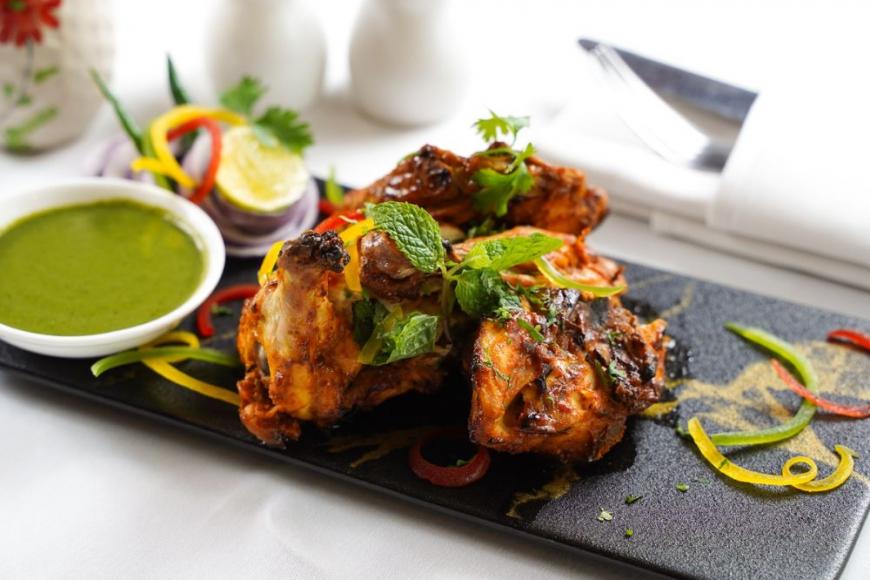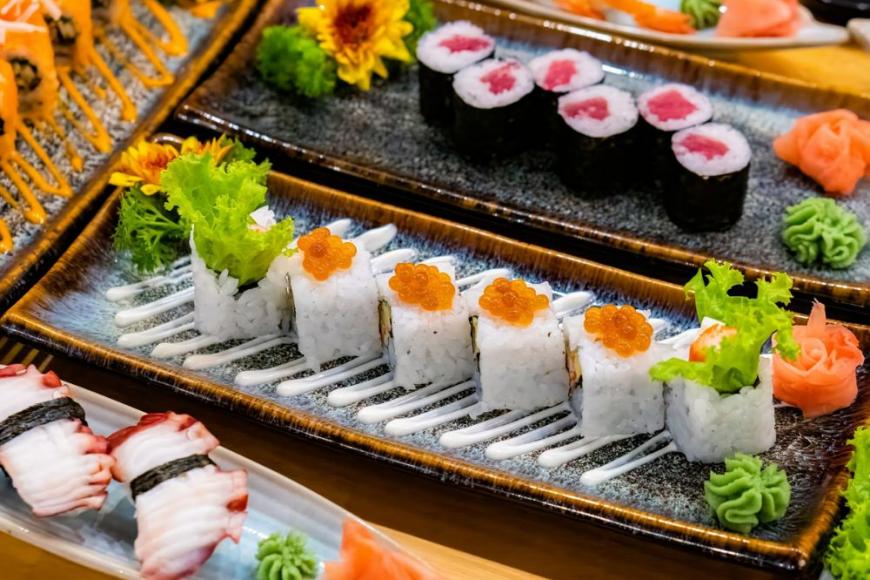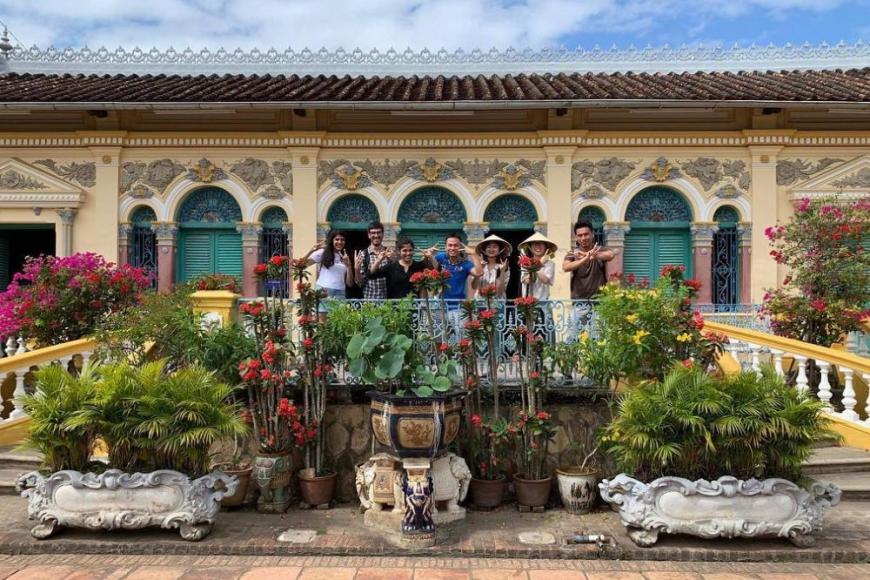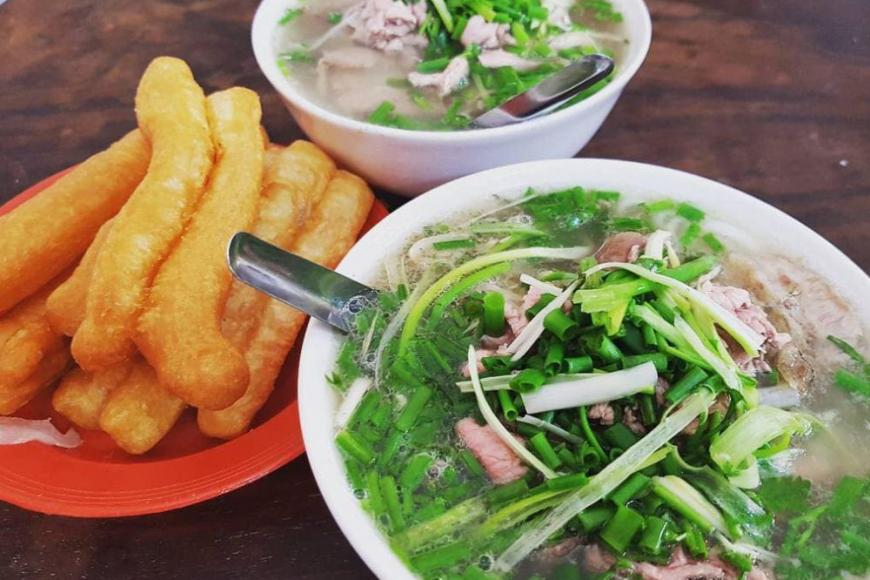- Nha Trang Travel Information
- Muine Travel Information
- Hue Travel information
- Cantho travel information
- Sapa travel information
- Ha Giang Travel Guide
- Ninh Binh Travel Information
- Quy Nhon Travel Information
- Vietnam Travel Information
- Hoian Travel Guide
- Vung Tau Travel Information
- Quang Binh Travel Information
- Phu Quoc Travel Information
- Ha Tinh Information
- Ca Mau information
- Quang Ninh Travel Information
- Tay Ninh Travel information
- Hoian travel guide
- Tien Giang travel guide
- Con Dao Travel information
- Ninh Thuan information
- Moc Chau information
- Danang Vietnam Travel Information
- Hanoi Travel Information
- Ho Chi Minh Travel Information
- Dalat Travel Information
History of Vietnam
The length of time covered by the history of Vietnam is measured in thousands of years. This article will take you on a tour through the history of Vietnam, analyzing the important periods that formed the nation at various points throughout its existence.
For countless years, people all across the world have been captivated by the heroic history of Vietnam. Over the course of its history, this nation's unmistakable character has been fashioned by the profound social and cultural shifts that have occurred alongside its never-ending fight for independence. Discovering Vietnam's long and illustrious history will give you a better understanding of the country's thriving culture as well as the tenacious willpower of its people.
Vietnam's historical periods
Stage 1:
| Stage | Historical event |
| 1 st millennium BC | The tonkin coast and Red river valley are home to thriving Dong Son cultures |
258 BC |
Kingdom of Au Lac.
|
|
208 BC
|
Kingdom of Nam Viet |
|
AD 39-42
|
The Trung sisters attempt a failed uprising against the Chinese. Chinese domination is imposed onto the Vietnamese people.
|
|
542-4 |
An rebellion against China is led by Ly Bon.
|
|
939-1009 |
three brief dynasties in succession: Ngo, Dinh, and Tien Le.
|
Stage 2
| Stage | Historical event |
| 1010-1225 | Ly Thai To founded Hanoi as Thang Long. |
| 1225-1400 | Additional centralization under the Tran dynasty. |
| 1400 - 1428 | Ho dynasty. |
| 1471 |
The Le dynasty comes to power and conquers the southern land of the Champa people.
|
|
1527 - 1529
|
Short-lived Mac dynasty.
|
| 1624 | Alexandre de Rhodes, a Jesuit priest, is responsible for the translation of Vietnamese into a Romanized method of writing. |
| 1672 |
The country is effectively split in two by warring factions of Trinh and Nguyen lords.
|
| 1771 - 1792 |
Tay Son Rebellion.
|
|
1802 - 1945
|
Nguyen dynasty.
|
| 1802 |
Capital moved to Hue.
|
| 1861 |
Within six years, the French will gain control of southern Vietnam after they have captured Saigon.
|
| 1883 - 1907 |
Several anti-French movements are put down completely.
|
Stage 3
|
Stage |
Historical event |
| 1919 |
At the Peace Conference at Versailles, Ho Chi Minh presents a petition that argues against colonial rule.
|
| 1926 |
Emperor Bao Dai ascends the throne.
|
| 1930 |
Ho Chi Minh is credited with founding the Indochinese Communist Party after rallying several communist parties.
|
| 1942 - 1943 |
Ho Chi Minh was placed under house arrest in China. He is allowed to go free, and his leadership of the Viet Minh is acknowledged.
|
| 1945 |
Japan is successful in removing French rule from Vietnam, which then becomes "independent" but remains under Japanese protection. The Japanese eventually capitulated to the Allied forces, the Viet Minh took control of the country, and Ho Chi Minh proclaimed Vietnam's independence at that time. The position of Emperor Bao Dai is vacated.
|
| 1946 |
After the French attempted to recapture Vietnam, hostilities broke out between the Vietnamese and the French.
|
| 1951 |
Ho Chi Minh announces the foundation of the Workers' Party while also consolidating the Viet Minh organization.
|
| 1954 |
The French were victorious over the Vietnamese at Dien Bien Phu. The Geneva Accord draws a line that divides Vietnam at the 17th parallel. Ho Chi Minh rules communist North Vietnam, while Ngo Dinh Diem governs democratic South Vietnam.
|
| 1955 |
The level of hostility between North Vietnam and South Vietnam has increased. Beginning of direct help from the United States to South Vietnam.
|
| 1959 |
The Ho Chi Minh trail is used by North Vietnam to enter South Vietnam.
|
| 1963 |
Ngo Dinh Diem was removed from power and then killed shortly after.
|
| 1965 |
The United States of America bombs military targets located in North Vietnam. Danang is the location of the initial landing of ground combat soldiers from the United States in Vietnam.
|
| 1968 |
The Tet Offensive, started by the Viet Cong, is the event that marks the turning point in the Vietnam War. The venue for the start of peace talks is Paris.
|
| 1979 | Ho Chi Minh dies, aged 79. |
| 1973 |
The Paris Peace Agreement brings an end to the fighting. The final American soldiers have left.
|
| 1975 |
North Vietnamese forces invade the city of Saigon. The government of South Vietnam abdicates its responsibilities. Ho Chi Minh City will now be known as Saigon |
| 1976 |
The communist regime has been reinstated, and Vietnam has been reunified as a nation.
|
| 1976 - 1985 | A time of tremendous financial strain for the nation. The new government persecutes millions of people, who are referred to as "boat people," and they flee in boats.
|
| 1977 |
Vietnam admitted to the UN.
|
| 1978 - 1979 |
A friendship treaty was signed between Vietnam and the Soviet Union. Conflicts with Cambodia and China, respectively.
|
| 1986 | Doi moi is the program's name that will help revitalise the socioeconomic system. |
| 1994 | US lifts trade embargo. |
| 1995 |
The United States has resumed diplomatic relations with the country. The Association of Southeast Asian Nations (ASEAN) has decided to accept Vietnam as a member.
|
| 1997 |
The economic crisis in Asia has caused investors to flee Vietnam.
|
Stage 4
| Stage | Historical event |
| 2000 |
Bill Clinton is the first sitting President of the United States to visit Vietnam since the end of the war. |
| 2001 |
The United States and Vietnam have agreed to a trading partnership. The level of investment from overseas grows. |
| 2007 | Vietnam joins the WTO |
| 2008 |
The economy is suffering due to the skyrocketing prices of food and fuel.
|
| 2011 | Inflation rises and the currency is devalued |
| 2014 |
The dispute over the Paracel Islands has become more heated due to China's deployment of a drilling rig in the surrounding waters. This has resulted in violent demonstrations and many collisions between Vietnamese and Chinese vessels.
|
| 2016 |
Through the discharge of toxic waste into the ocean along the central coast, Ha Tinh Steel is responsible for the death of millions of fish and other forms of marine life.
|
| 2017 | An unprecedented number of storms are responsible for the deaths of around 400 individuals. |
Pre-dynastic history of Vietnam
As Vietnam united to become a nation, dynasties came and went swiftly. Vietnam was first affected by China in the north, but later faced a new challenge in the form of French colonialists.
Vietnam's ancient past is shrouded in myth; historians have only been able to put together the country's origins by combining historical accounts from Chinese and Vietnamese sources with folklore from Vietnam and recent archaeological finds.
The legend of Vietnam starts nearly 5,000 years ago in the northern Red River Delta, where a strong dragon lord named Lac Long Quan and a mountain fairy named Au Co are said to have sired exactly 100 sons. Afterwards, the oldest of these boys was crowned Lac Viet king, assuming the title Hung Vuong (Brave King) and named his realm Van Lang.
Note that the Vietnamese state is generally seen as having originated in the north of the nation; power further south was vested in the Hindu Cham in the center and in several Khmer kingdoms in and around the Mekong Delta; these regions were only incorporated into the Vietnamese state at a much later date in its history.
Afterwards, Van Lang's account was disregarded by French colonialists, who said they were only myths. However, it is now known that this kingdom, which formerly covered most of what is now northern and central Vietnam, was powerful and well-organized. It is claimed that during the first millennium BC, it flourished under the authority of eighteen Hung rulers in succession until Thuc Phan, king of adjacent Au Viet, conquered the Lac Viet in 258 BC. After that, he changed his name to An Duong Vuong (Peaceful Sun King) and founded the new Au Lac empire, with Phuc An serving as its capital. His citadel's ruins can be found north of Hanoi in the modern hamlet of Co Loa.
During this period, a matriarchal society—sometimes called the Dong Son culture—is believed to have predominated. Dong Son, which peaked between 500 and 200 BC, is most remembered for its exquisite bronze decorations and intricately carved wooden drums.
The Dong Son civilization, named after a small village in northern Vietnam, produced fine bronze sculptures as early as 300 BC and spread from northern Vietnam into Cambodia, Laos, and even Indonesia.
The Power And Impact Of China
The Au Lac monarchy was overthrown by northern hordes under the command of a South Chinese general named Trieu Da about 200 BC. In 208 BC, he formed the Trieu dynasty and the autonomous kingdom of Nam Viet, which encompassed a large portion of modern-day southern China. His capital was close to what is now known as Canton, or Guangzhou.
As the Han dynasty united China, Nam Viet progressively fell under Chinese dominance. The plains of northern Vietnam were incorporated into the Chinese colonial province of Giao Chi (Jiaozhi) around 111 BC. China recruited administrators as governors to control the nation, but the Viet people fiercely resisted their attempts to impose Chinese culture on them.
The Vietnamese, fed up with years of Chinese influence and culture, not only defended but also vigorously struggled to establish their own identity. The change from protest to insurrection was initiated by a fearless woman named Trung Trach, who belonged to an elite class of indigenous people. She spearheaded a rapid uprising in AD 39 with her sister Trung Nhi, forcing the Chinese authorities to escape. Despite being crowned queen, Trung Trach's rule was brief. Three years later, in a drawn-out battle led by a general named Ngo Quyen, the more powerful Chinese army retook control of the nation. The two women, referred to as Hai Ba Trung (Two Trung Ladies) in Vietnamese, killed themselves after defeating the Chinese reinforcements. They are recognized as national heroes today.
The Cham Civilizations Rise and Decline
The Cham civilization was first documented near the close of the second century AD. The Cham people gained power through marine trade and experienced a greater degree of Indianization as a result of their commercial ties to Southeast Asia and India. By the fourth century, Sanskrit was the primary language of communication and Hinduism had gained traction. Champa ruled over the whole central coast at its height of power, extending from the Hoanh Son Pass in the north to the region surrounding Vung Tau in the south.
The most famous features of the Cham civilization are its towers and temples made of brick, which can be found strewn all across the coast of central and southern Cambodia, the former home of the Cham kingdom. The Cham remains at Po Nagar at Nha Trang and My Son near Hoi An still display their magnificent masonry and superb sculpture, even though they cannot be compared to the equally Indian-influenced Angkor in Cambodia or Pagan in Burma.
By the end of the 15th century, Champa had been reduced to a small area close to Nha Trang due to the territorial ambitions of succeeding Viet rulers. The final Cham ruler and his subjects escaped to neighboring Cambodia in 1720. There are currently only 100,000 Cham people living in southern Vietnam. The majority became Muslims centuries ago, but there are still tiny populations of Cham Hindus and Buddhists. For additional information about the Cham.
Kingdoms of Khmer and Cham
Present-day central and southern Vietnam were greatly impacted by marine trade with India and Southeast Asia, and were not under direct Chinese rule. The remote south was a component of the Khmer Funan empire, which subsequently gave rise to the Chen La dynasty and the eventual establishment of Angkor. The strong Cham kings ruled over most of the center starting in the second century AD.
Rebels with a reason
Nam Viet was governed as a Chinese province called Giao Chau (Jiaozhou) following the suppression of the Trung sisters' uprising. However, in the sixth century, a scholar by the name of Ly Bon launched an armed uprising and was successful in driving away the Chinese. After being crowned emperor, Ly Bon dubbed the empire Van Xuan (Eternal Spring) and adopted the moniker Ly Nam De (the Southern Emperor) for himself in AD 544. His dominion did not last long, though, as the Chinese rapidly reclaimed their dominance in the region in 545.
After escaping to Laos, Ly Nam De passed away there. Although the Chinese were eventually driven out of Van Xuan in 550 by his successor, the accomplished general Triet Viet Vuong, the Chinese eventually returned and resumed control in 603.
Now ruled by the rich Tang dynasty, the Chinese once more began a determined effort to impose their civilization and culture on Nam Viet, which they renamed An Nam. However, the Vietnamese's armed uprisings continued to be a source of frustration for them. Rebel commanders who rallied the populace to overthrow the Chinese authorities included Mai Hac De in 722 and Phung Hung in 791. China eventually dispatched reinforcements, ending their short regimes. But every uprising saw the birth of a new folk hero, spurring the creation of more shrines and tales, which only fueled the determination to drive out the Chinese.
Early Dynastices
As the Tang dynasty in China came to an end, chaos followed, providing the Vietnamese with an opportunity to declare their independence. A general by the name of Ngo Quyen defeated Chinese reinforcements in a protracted battle, establishing the first Vietnamese empire in 939. He returned Co Loa to be the capital city and renamed the nation Dai Viet. His death in 967 sent the kingdom into disarray, and it stayed that way for over two decades, with the Song dynasty of China posing a serious danger to the north.
Dinh Bo Linh, the most powerful feudal lord, eventually brought the broken nation back together under the name Dai Co Viet and assumed the imperial title Dinh Tien Hoang De, meaning "The First August Emperor Dinh." He prudently negotiated tributes to be paid to the Chinese every three years in exchange for a non-aggression treaty.
Dinh Tien Hoang set up his royal court in Hoa Lu, the new capital of Ninh Binh province, which is located 100 kilometers (62 miles) south of Hanoi. He established a strict legal system and made the death sentence available to anyone who dared to challenge his authority. As security and order were gradually restored, a new period of peace was ushered in. Nevertheless, a palace guard killed the emperor in 979. Since the heir apparent was only six years old, Le Hoan, the commander of the court, took over and crowned himself Emperor Le Dai Hanh. Though he was able to repel the Chinese, he did not stop giving them tribute.
Le Dai Hanh attempted to calm the south once a semblance of calm was established on the northern border. A military campaign against the Champa kingdom—which would progressively be subsumed over the ensuing centuries—was initiated in 982. The emperor also aimed to unite the people of Vietnam. In order to better govern the nation, he built a road network. But a string of regional uprisings guaranteed Le Dai Hanh's tough reign for 24 years, until his death.
LY DYNASTY
The first national dynasty to rule the land for over two centuries was the Ly dynasty, which ruled from 11009 until 1225. Ly Cong Uan's ascent to prominence was aided by Van Hanh, a monk, who taught him. The new ruler, Ly Thai To, relocated the capital to modern-day Hanoi and called it Thang Long (Ascending Dragon) upon observing the appearance of an ascending dragon at the suggested location. Buddhism emerged as the official national religion throughout the Ly dynasty. Buddhist gurus served as advisors to the Ly kings. Buddhist sects were also led by a number of Ly rulers. During the Ly dynasty, Confucian studies were also emphasized. The Temple of Literature, built in Thang Long in 1070, was devoted to Confucius.
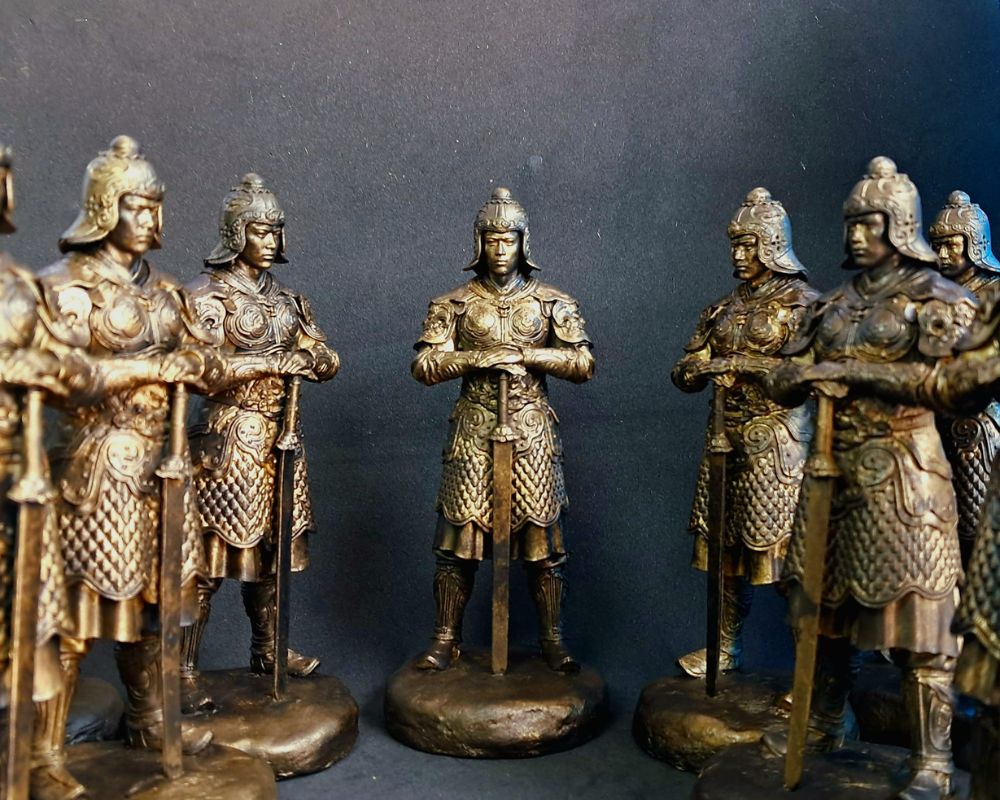 Armor set of the Ly Dynasty, simulated King Ly Thai To (Ly Cong Uan 974-1028)
Armor set of the Ly Dynasty, simulated King Ly Thai To (Ly Cong Uan 974-1028)The Ly dynasty established Confucianist ideas in the consolidation of the monarchy. It instituted a professional army, a tax system, a court, and a centralized government. In order to expand agricultural, significant public works were built, including as dykes and canals in the Red River Delta region.
TRAN AND HO DYNASTIES
Tran Canh, an aspirational commoner, wed into the royal family of the Ly dynasty and cunningly maneuvered his way up to establish the Tran dynasty (1225-1400). During this time, the Mongols under Kublai Khan, who had taken over China and established the Yuan dynasty, launched three invasions against the Viet army in 1257, 1284, and 1288. One of Vietnam's greatest military heroes, Tran Quoc Toan (better known as Tran Hung Daol), was the mastermind behind the last two wins. His strategy was to counter the Mongols at their weak places, which were swamps and rivers, and avoid their might in open field battles and city sieges (the Tran court abandoned the capital and the cities). The Mongols withdrew only to be defeated in 1288 at the Bach Dang River.
The nation persisted in its territorial aspirations towards the south. By means of a diplomatic marriage, the king's sister wed the king of Champa in 1307, allowing for the peaceful absorption of the Hue region. This resulted in the extension of territory southward.
The Tran dynasty began to fall apart toward the end of the fourteenth century. Under his ancestor Ho, a political opportunist named Le Quy Ly skillfully maneuvered his way to prominence and established a dynasty. Even though he was successful in launching a number of financial, educational, and economic reforms, China launched another offensive under his rule.
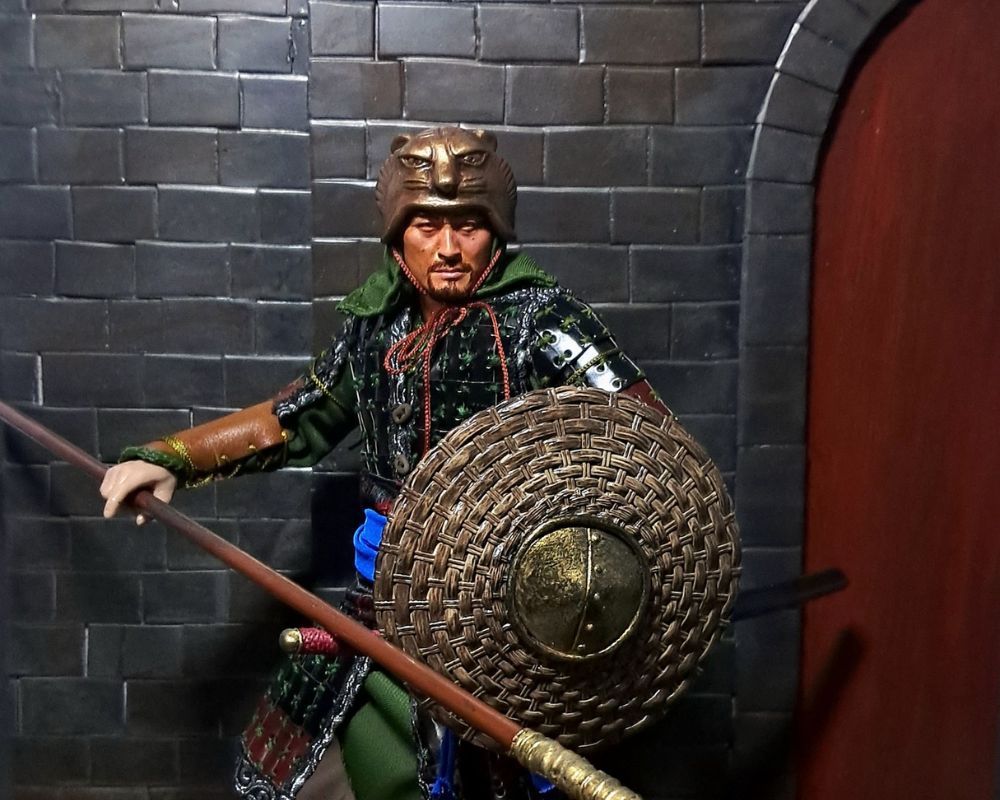 Simulation of the Ho Dynasty infantry in the Da Bang battle.
Simulation of the Ho Dynasty infantry in the Da Bang battle.The Chinese Ming dynasty emperor despatched 5,000 soldiers under the guise of aiding the devoted adherents of the overthrown Tran dynasty, knowing that the new monarch had taken the throne. The Ho dynasty was overthrown in 1407 as a result of Ming involvement. Following a brief time of Chinese occupation, the Vietnamese were subjected to cruel exploitation. Chinese efforts to erase Vietnamese national identity included burning or removing Vietnamese literature, artwork, and historical works, as well as substituting Chinese classics for Vietnamese texts in classrooms. Vietnamese women were forced to wear and style their hair in a Chinese manner, Chinese religious festivals and rituals were adopted or modified, and personal wealth was taken.
LE DYNASTY
To organize a resistance force from his hamlet and fight the Chinese with guerrilla warfare, it took a guy named Le Loi, who was well-known for his bravery and kindness. Le Loi avoided battle with the stronger Chinese soldiers while weakening the opposition with surprise strikes. He became a well-liked military hero because his tight military discipline made sure that his troops in the areas he ruled did not commit any pillaging.
In 1428, Le Loi established the Le dynasty and assumed the throne as Le Thai To. Following the devastation brought forth by the war, he renamed the nation Dai Viet and got to work rebuilding it. In order to increase food production, he lowered the size of his army from 250,000 to 10,000 men and instituted a rotation system that allowed soldiers to return to the countryside for work. Both the penal and legal systems underwent revisions and reorganizations. A new college was formed to train future administrators, with admittance based purely on merit and not on social or family position.
Following the unexpected death of Le Thai To in 1443, his son Le Thai Tong assumed the throne. However, a decade of disarray and intrigues within the royal court ensued after Le Thai To's untimely demise. When Le Thanh Tong commenced his 36-year rule in 1460, this turbulent era came to an end, and the country pros failed like never before.
He changed the tax code, promoted agriculture, and gave morality and customs a lot of weight. He wrote the first history book of Vietnam. In 1471, Le Thanh Tong's reorganized army easily defeated the army of the southern Champa. Not only were his farmer-soldiers exceptional in the battlefield, but they also excelled in the fields, establishing militarized agricultural villages everywhere they went. In this manner, the country's territory progressively grew southward until the Champa kingdom was eventually fully annexed.
SECESSION WARS
The realm was divided into two rival principalities as a result of the Le dynasty's growing decadence in the late 16th century and the corrupt and incompetent rulers that followed Le Thanh Tong. A cunning and cunning advisor to the court, Mac Dang Dung took control of the north, including Hanoi, and established the short-lived Mac dynasty in 1527. Concurrently, the Le dynasty's progeny coalesced around Nguyen Kim, a former Le court official, and his son-in-law Trinh Kiem established the southern court in 1543 close to Thanh Hoa, some 120 kilometers (75 miles) south of Hanoi. Until the death of Mac Mau Hop, the final monarch of the Mac dynasty, in 1592, a protracted civil war raged on without conclusion.
Trinh Kiem left the southern court, temporarily ruled by Nguyen Hoang, the nephew of Nguyen Kim, and headed north, intending to bring law and order back to the Mac dynasty's domain. Trinh Kiem returned after bringing peace to the area to discover Nguyen Hoang had established himself as the supreme ruler in the southern court.
A century of largely peaceful relations between the two sides allowed the Nguyen Lords to continue their expansion into the Mekong Delta. South of Phu Xuan, in Quy Nhon Province, a revolt began in 1771. A man named Nguyen Hue Ino (not related to the Nguyen Lords) and his two brothers staged a peasant rebellion known as the Tay Son Rebellion, which toppled the Nguyen Lords, as a result of corruption within the imperial court and the north-south conflict. After seizing power in the south of the country, the Tay Son brothers went on to vanquish the Trinh Lords in the north and, in a bold move, the Chinese forces occupying Thanh Long. Amazingly, a peasant uprising had brought Vietnam together.
NGUYEN DYNASTY
In 1788, Nguyen Hue crowned himself Emperor Quang Trung and set about rebuilding the nation. Sadly, his early death in 1792 ended his potential reign.
Nguyen Anh, one of the last Nguyen Lords, had not given up on gaining control for himself in the interim. He made friends with Pigneau de Behaine, the Bishop of Adran, a French Catholic. De Behaine recognized a chance to strengthen the Catholic Church's position and persuade the French government to grant Nguyen Anh military support in return for territory and commercial rights in Vietnam. But the promised aid never materialized because the French were preoccupied with other domestic conflicts. The bishop, unfazed, organized finances and personally gathered soldiers. Nguyen Anh's army benefited greatly from training in Western military tactics, which helped them defeat the last of the Tay Sons in 1801. Declaring himself Emperor Gia Long, he established the Nguyen dynasty in 1802.
Though he owed his accession to the French, Nguyen Anh harbored misgivings about their intentions. Consequently, in order to establish his empire, he depended more on the support of Confucian mandarins than on Catholic missionaries. The reunified and renamed Viet Nam stretched from the Chinese border to the Ca Mau Pen, where the southern Nguyen Lords engaged in obscene combat, which is located at the southernmost point of the country. Considerable effort was put into developing the national administration based on Confucian ideals and codifying the law. After Hue was established as the nation's new administrative center, ornate palaces, mausoleums, temples, and pagodas were constructed. The Nguyen kings expanded Vietnam's borders into Laos and Cambodia, forming vassal nations out of portions of these two countries. They feared that the strengthening of economic ties would threaten the foundations of the Nguyen monarchy, so they sealed off the nation from Western incursions from the sea.
THE FRENCH CONNECTION
During his discussions with the French government, de Behaine was accompanied to France by his eldest son, Prince Canh, who was born in Vietnam. Later, the prince received his education in a missionary school in Malacca and became a Catholic. Canh became the first Vietnamese royal to receive a Western education as a result. Military officials in Nguyen Anh's army desired to use Prince Canh's expertise to rebuild the nation after the war because they recognized the superiority of contemporary Western military technology. Canh was seen to be the one who could bring Vietnam up to date.
However, Chinese court ministers encouraged Canh's younger brother, Mien Tong, to succeed to the throne upon Gia Long's death in 1820. The French faction's ally, Prince Canh, was said to have died of measles at the age of 21, although court-affiliated missionaries claimed he had been poisoned. Following Mien Tong's coronation as Emperor Minh Mang, the French-Chinese divide was declared to be over. The majority of Canh's supporters were executed or demoted.
Emperor Minh Mang became vehemently anti-Catholic "lest they spread dark-ness in the kingdom" as a result of Catholic missions stepping up their proselytizing efforts in the interim.
The French now had the ideal justification to get involved in Vietnam. This time, however, the familiar cycle of invasion and occupation started over from a distance. An almost century-long period of colonial occupation began at Danang in 1858 with the landing of a French force. The Vietnamese imperial court in Hue denied the French government's requests for a French consulate and commercial attaché in Danang, despite the French government's desire for a strategic and religious sphere of influence in Indochina (modern-day Vietnam, Laos, and Cambodia). In retaliation for the insult, the French captured Danang.
The Nguyen Emperor Gia Long sent an envoy to China at the beginning of the 19th century to request permission to reunite the ancient An Nam with the newly formed Viet Thuong, as well as to rename the nation Nam Viet. However, the Chinese emperor was told that Gia Long might have hidden his territorial intentions under the name Nam Viet, as it would evoke memories of the former Nam Viet Dong kingdom, which had incorporated two Chinese provinces. To give the nation the name it has today, the two terms Viet (people) and Nam (south) were simply flipped.
Resistance against both France and the United States
After a century of French colonization, the devastating Vietnam fight quickly succeeded the deadly fight of independence. The nation came out of these wars scarred but united.
After the French captured Saigon in 1861, the entire southern portion of the nation was seized as a French colony and renamed Cochinchina in less than six years. Under the Nguyen dynasty's nominal authority, central and northern Vietnam were made into French protectorates in the 1880s. The north of Vietnam became Tonkin, and the central region was dubbed Annam.
Under French rule, the Vietnamese had not been much happier than they had been under Chinese rule. In occupied areas, peasants and former court officers headed different resistance activities. Even the youthful Nguyen monarch Ham Nghi began an anti-French campaign before being taken prisoner and banished to Algeria.
Leading one significant opposition movement were radical Confucian scholars Phan Boi Chau and Phan Chau Trinh, who supported democracy and were primarily made up of intellectuals, young people, and aristocrats. The Japanese victory over Russia in 1904-5, which gave them hope that Western forces were not unbeatable, served as the impetus for this movement.
In 1907, Phan Boi Chau founded the Eastward Movement (Dong Dul) and sent students in secret to study under the Japanese. After learning of the plot, the French government engaged in negotiations with Japan to have the Vietnamese students extradited. Nonetheless, others were assisted by Japanese officials in fleeing to China, where they witnessed Sun Yat-sen's 1911 revolution. They were persuaded by this that Vietnam was prepared for a coup of a similar nature.
However, the revolutionaries lacked unity. Between the nationalist Phan Boi Chau and the Westernized reformer Phan Chu Trinh, a schism grew. In the 1950s, the latter gave rise to the Vietnam Quang, the fabled Ho Chi Minh.
Phan Chu Trinh maintained that democracy was the only path to Vietnam's independence, while the Phu Hoi Party organized military resistance against the French. He traveled to Paris in 1915 in an attempt to mobilize radical French politicians and Vietnamese refugees to help the fight against colonial control.
YOUNG LEADER - PRESIDENT OF HO CHI MINH
Vietnamese history was significantly shaped by the Russian Revolution of 1917, mainly due to its impact on Nguyen Tat Thanh, a teenage revolutionary who would later become known as Ho Chí Minh.
Ho presented an anti-colonial petition at the 1919 Versailles Conference under the pseudonym Nguyen Ai Quoc. As many peasant uprisings are being staged by communist parties, he got involved in a military revolt. The French Communist Party was founded in 1920 by intellectuals from France. After that, the French took harsh steps against the new organization in Moscow to train them as Communist International agents (Cemintern).
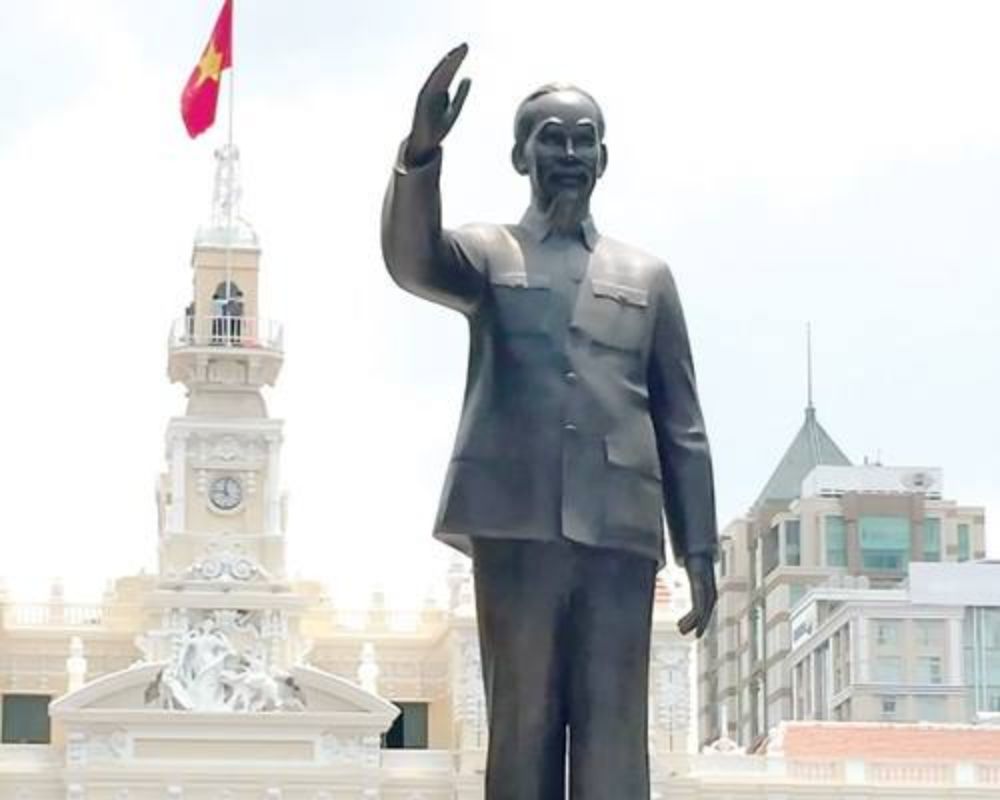 President Ho Chi Minh monument in Ho Chi Minh City
President Ho Chi Minh monument in Ho Chi Minh CityHe was deported to China in 1924, where he committed World War II fraud. tested youthful Vietnamese rebels and established the Vietnamese Youth Association.
As important as the Dai was transported to France for his edu- French occupation of Danang in 1858, Bao was also a historic event. It would take them till 1932 to return to Vietnam.
The French would not really make any concessions, despite the Vietnamese waiting to see whether they would take a more liberal stance. Ho organized a number of communist organizations and established the Indochinese Communist Party in 1930. Communist organizations organized multiple peasant uprisings in the same year that the Quoc Dan Dang (Vietnam Nationalist Party), led by the revolutionary Nguyen Thai Hoc, launched a military coup. The first World War II conflicts broke the seeming quiet that followed the retaliatory actions taken by the Frend against the budding movements.
Communism Consolidates
When World War II broke out in 1753, the Nazi Vichy government in France permitted the Japanese troops to occupy Indochina, provided that it could still rule Vietnam. The Revolutionary League for the Independence of Vietnam, or Viet Minh, was established in 1941 when the Indochinese Communist Party's Central Committee convened in China.
Vietnam was left with a political vacuum in 1945 after Japan toppled the French, jailed their civil personnel, and declared the country "autonomous under Japanese "protection," with Bao Dai serving as the head of state. After the Japanese loss in the middle of August, there was an air of confusion and uncertainty. Ho attempted to establish himself as the dominant political power by seizing as much territory as he could through the covert Indochina Communist Party and the Viet Minh as go-betweens.
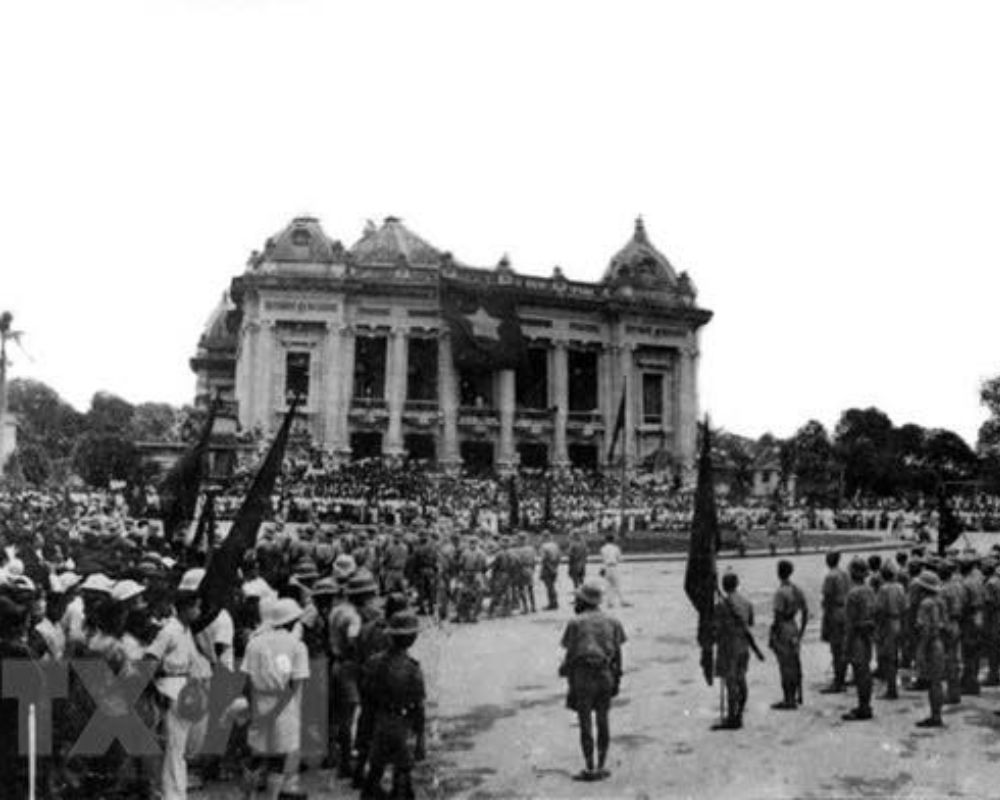 Ho Chi Minh read the declaration of independence at Ba Dinh Square
Ho Chi Minh read the declaration of independence at Ba Dinh SquareThe August Revolution
The Viet Minh declared on August 16, 1945, that a National Committee of Liberation for Vietnam would be established. Hanoi fell to Ho's guerrilla forces three days later. Four days later, Hue's time came when the government of Bao Dai was besieged and "asked to hand over the royal seal." Following Bao Dai's abdication, Ho declared himself the head of the newly formed Democratic Republic of Vietnam and announced the establishment of a provisional administration in Hanoi.
But the situation was unstable. While the French attempted to retake their old territory, the British arrived in Saigon with the intention of disarming the Japanese and restoring order. Chinese spies infiltrated Vietnam from the north with the intention of disarming the Japanese.
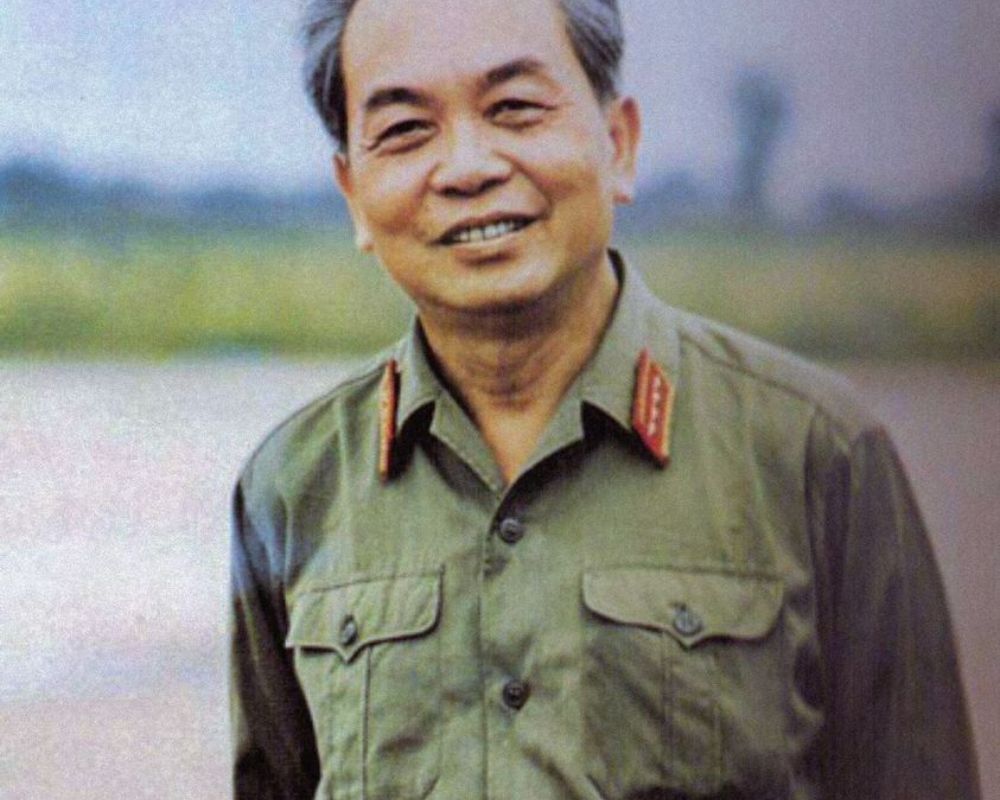 General Vo Nguyen Giap
General Vo Nguyen GiapThe Viet Minh gained a majority in the first National Assembly following the national elections that were held in early 1946. After the approval of the nation's first national constitution and the French government's five-year stay, the Democratic Republic of Vietnam was acknowledged as a free state inside the French Union. But ties between the French and the Vietnamese began to deteriorate. When the French bombed Haiphong Port, east of Hanoi, hostilities peaked. Ho gave the command for an onslaught against the French in Hanoi and at their outposts in northern and central Vietnam in December 1946. A 30-year conflict had broken out over independence.
WAR OF RESISTANCE
Few Vietnamese were aware of the identity and allegiance of their new leader and his party, even though thousands of them took up arms against the French. major Vo Nguyen Giap, Ho's main ally, ordered a major onslaught against the colonial army, but the Vietnamese troops withdrew into the countryside when confronted with overwhelming gunfire. Instead of getting involved in large-scale battles, they chose to target and subvert individual French groups, following Mao Zedong's guerilla strategy of a "people's war and people's army"—a move reminiscent of Le Loi's 15th-century tactics against the Chinese.
China and Vietnam first had direct touch after Ho's fighters destroyed several French outposts along the Chinese border. China, the former aggressor, was now an ally, providing the fledgling republic with huge supplies of food and military hardware.
Ho tried to fortify the nationalist base on his side. He united the Patriotic Front, also known as the Lien Viet, with the Viet Minh to form the National Union of Vietnam in 1951. Additionally, Mao declared the creation of the Workers' Party (Lao Dong), which was really the Communist Party under a covert cloak that continued to operate despite its apparent dissolution. The new government and the French colonialists were the only options available to nationalists and non-communists.
THE GENEVA AGREEMENT
General Vo Nguyen Giap's men, who were renowned for using bicycles to transport supplies, launched a major artillery attack on the French position at Dien Bien Phu in May 1954, resulting in a humiliating and historic defeat. The French forces in northern Vietnam withdrew to Danang, which is below the 16th parallel. The formal end of the conflict came on July 20th, following protracted talks in Geneva.
But Vietnam's unity was lost in the process of achieving eventual independence. In anticipation of the 1956 general elections, the country was divided at the 17th parallel by the Geneva Agreement, which was signed in August. Under the direction of Ho Chi Minh, the country's north became the Democratic Republic of Vietnam, or communist North Vietnam, and its south became the Republic of South Vietnam.
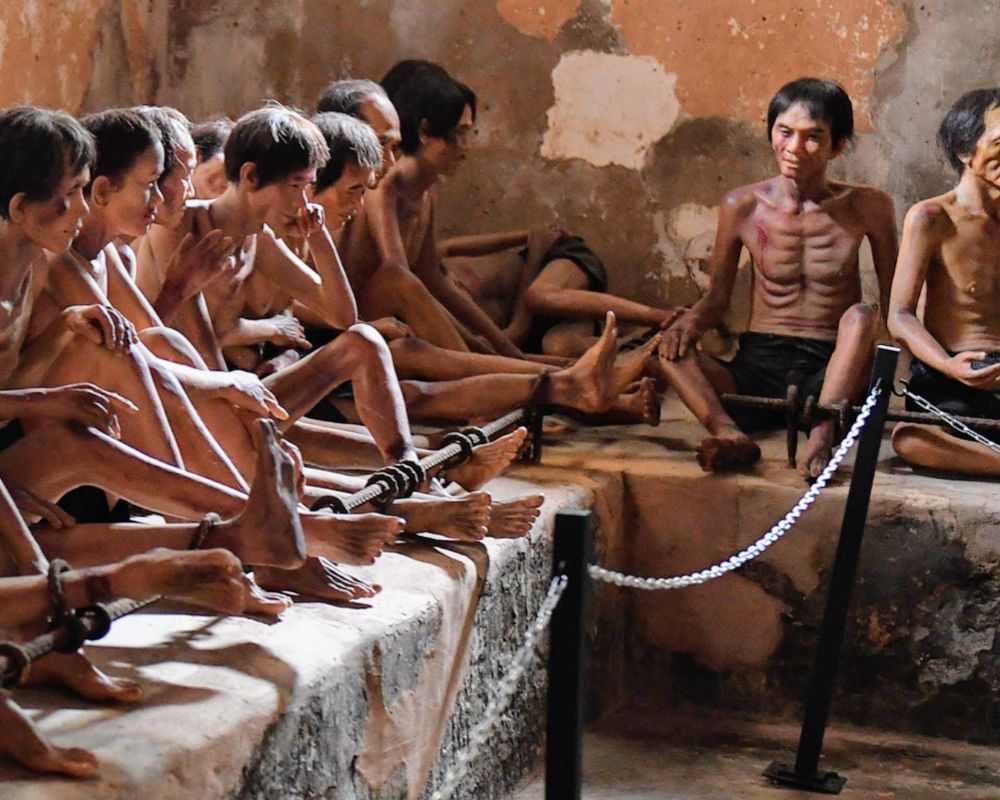 Con Dao Prison
Con Dao PrisonThe last French soldiers had left Indochina and Vietnam by this point. After his abdication, the French convinced Bao Dai to return from exile. He then pleaded on behalf of the royalists and urged Ngo Dinh Diem, a former minister in Bao Dai's court, to take over as prime minister of the future South Vietnam. Ngo was an unusual pick because he was a Catholic living in a mostly Buddhist country after 20 years abroad. Following a false vote, Ngo Dinh Diem overthrew Bao Dai, ushering in the Republic of South Vietnam. However, it paved the way for the deadliest and subsequent war in Vietnam rather than bringing about stability.
THE BATTLE OF DIEN BIEN PHU
The battle of Dien Bien Phu in 1954, masterminded by General Vo Nguyen Giap, marked a turning point in Vietnamese history. The French strategy was to force the Viet Minh into a large-scale battle which France would, presumably, win. In December 1953, a defensive complex was built at Dien Bien Phu, which would block the route of the Viet Minh forces trying to return to camps in neighbouring Laos,
General Vo's first task was to dig a trench that encircled the French fortification. From the outer trench, more tunnels were dug inwards towards the centre. In this way the Viet Minh could close in on the French troops while escaping fire. Meanwhile, reinforcements arrived. Soon General
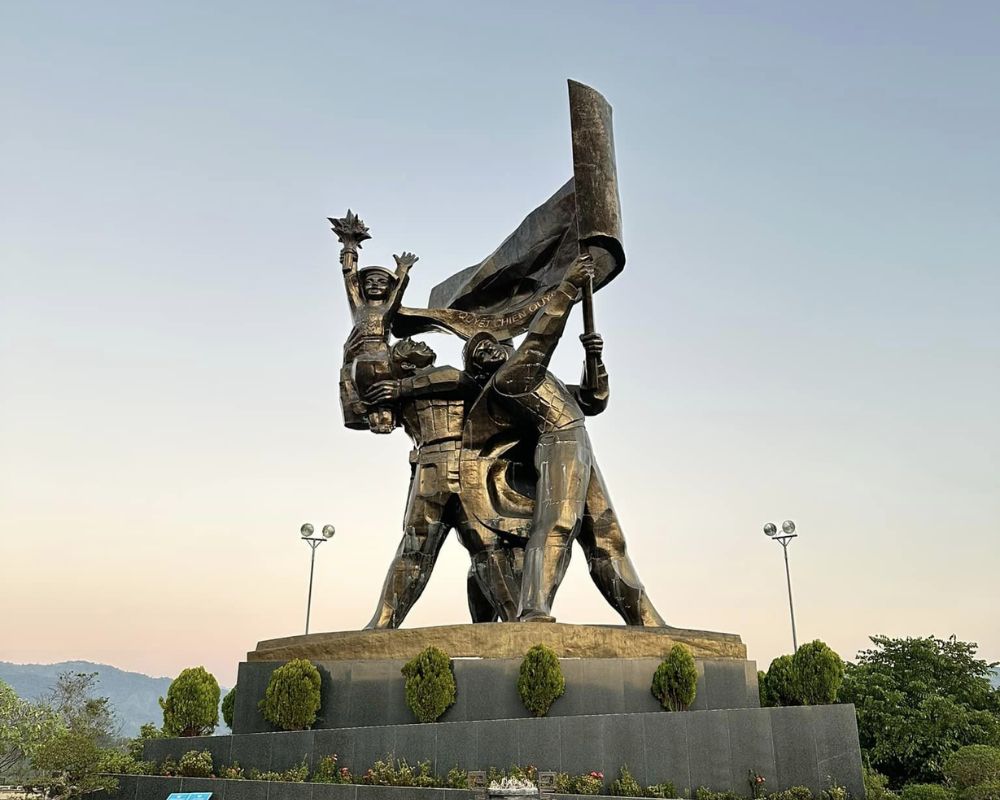 Dien Bien Phu Museum
Dien Bien Phu MuseumVo had 70,000 soldiers surrounding Dien Bien Phu, five times the number of French troops. Employing recently obtained anti-aircraft guns and howitzers from China, he severely restricted the ability of the French to supply their forces in Dien Bien Phu.
On 13 March 1954, General Vo launched his offensive and for 56 days the Viet Minh pushed the French forces back until they only occupied a small area of Dien Bien Phu. The French surrendered on 7 May, after 13,000 of their men and another 25,000 of the Viet Minh had died. Shortly after, the war ended with the 1954 Geneva Accord, under which France agreed to withdraw from its former Indochinese colonies in Asia.
THE NORTH-SOUTH DIVID
The 1956 elections that were scheduled by the Geneva Agreement never happened. The two Vietnams had no diplomatic, cultural, or commercial ties to one another from 1954 and 1974. There was a virtual state of war between the two separated regions of the country right after the Geneva Agreement. North Vietnam's enhanced armed and revolutionary activities made the idea of reunification increasingly implausible.
In the meantime, the US saw the Vietnam War to be a component of a greater worldwide struggle against communism. It effectively transformed South Vietnam into an American military protectorate by bolstering Ngo's forces. The National Liberation Front (NLF), established in December 1960 by North Vietnam, initiated revolutionary activities against the increasingly oppressive and insecure dictatorship of Ngo. Early in the 1960s, the Viet Cong, its communist ally in South Vietnam that battled both the US and Ngo's administration, gained strength. North Vietnam dispatched more troops from the North Vietnamese Army (NVA) to support the Viet Cong.
Ngo, a devoted Roman Catholic, authorized harsh actions against the Buddhist establishment in response to growing pressure from his own people. This led to a surge of Buddhist monk suicides where they burned themselves on fire. A 66-year-old monk named Thich Quang Duc set himself on fire on a Saigon street corner in June 1963.
This meant that Ngo's rule was coming to an end. After a coup supported by the US, he and his brother, Ngo Dinh Nhu, the head of the security forces, were killed five months later by Ngo's own officers.
Approximately 2 million civilian Vietnamese, 1 million North Vietnamese soldiers, 250,000 South Vietnamese soldiers, and 57,605 Americans had died by the time the Vietnam War came to an end.
AMERICAN INVOLVEMENT
President Lyndon Johnson of the United States began sending substantial forces into Vietnam in the beginning of 1965, marking the beginning of the country's active engagement in the conflict. Over 500,000 American and 100,000 Allied soldiers—mostly from Korea, Australia, and New Zealand—were present in Vietnam by the end of 1967.
The Viet Cong's surprise attacks on Saigon and other southern cities during Tet, the Lunar New Year, in 1968 are widely regarded as the war's turning point. A raid on the US embassy in Saigon as part of the "Tet Offensive" startled and humiliated the US. As the American people learned about crimes like the My Lai massacre, domestic opposition in the US gained political and social legitimacy. Johnson eventually declared that he would not seek reelection. During the election campaign, his opponent, Richard Nixon, had promised a covert strategy to finish the war; nevertheless, this strategy ultimately amounted to handing over most of the combat to the South Vietnamese.
Ho Chi Minh passed away in 1969 without seeing his efforts finished, and peace talks in Paris continued from 1968 until 1973. In 1973, US forces eventually withdrew as part of the Paris Peace Agreement, but US financial support for Southern Vietnam's military endeavors persisted. South Vietnam's ability to fight the war was effectively ended in 1975 when the communist forces from North Vietnam steadily advanced south and the Saigon regime fell. This was due to the US Congress's refusal to provide more military aid.
The last American troops and diplomats left the American embassy by helicopter as the north began its last offensive and the Northern Vietnam Army (NVA) captured Saigon on April 30, 1975. The Communist Party has finally emerged victorious from its protracted power fight. Vietnam could now focus on unification since it was free of foreign forces and rule.
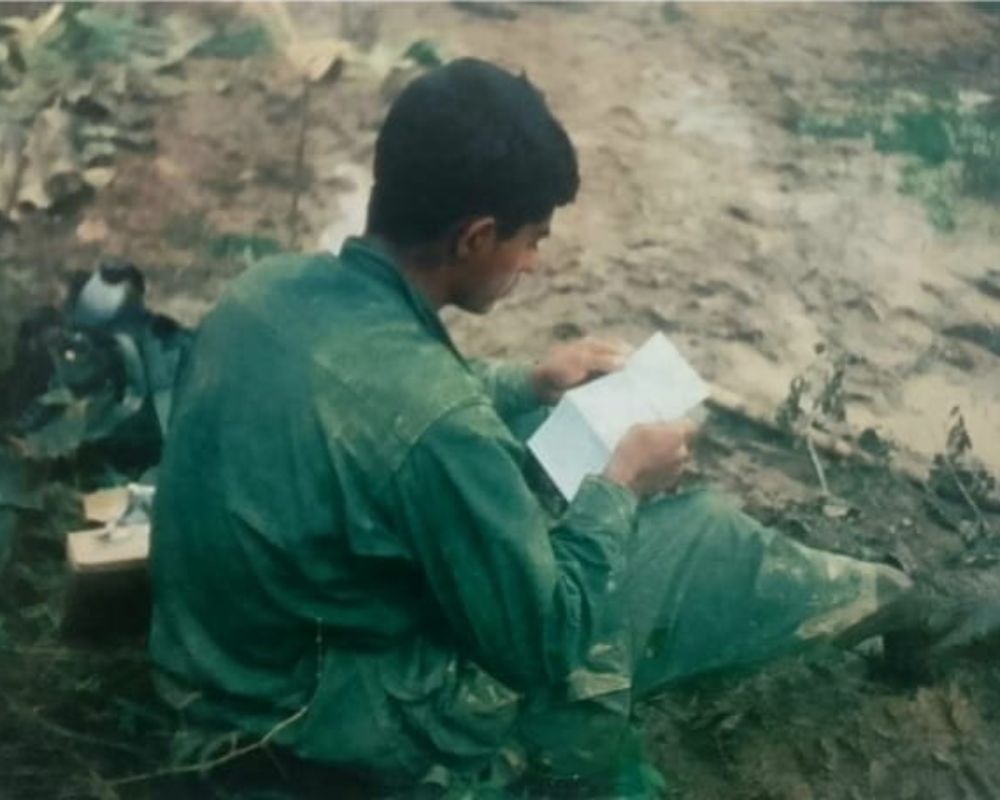 Vietnamese soldiers read letters sent from the rear
Vietnamese soldiers read letters sent from the rearThe slaughter that took place in My Lai on March 16, 1968, marked a sea change in how the world saw the Vietnam War. Within a span of thirty minutes, about five hundred Vietnamese citizens were brutally murdered by US forces. In what was fertile Viet Cong country, the soldiers had been sent on a "search and destroy" mission to eliminate communist combatants. There had not, however, been a gunfight with the Germans. Actually, not a single shot was directed against the US soldiers. The revelation of the My Lai narrative damaged the reputation of the US army and gave the anti-war movement, which was then gaining traction in the country, more impetus.
>>> See more: TOP 15+ BEST DESTINATIONS TO VISIT IN VIETNAM
other
Indian cuisines are quite unique and rich, attracting tourists from all over the world to explore and try them. Each Indian food is an ingenious combination of spices and elaborate processing of the Indians. If you don't know what food you should try, find the top 15 Indian dishes in this guide.
Japanese food is one of the traditional diversities of world cuisine with many famous foods. So, do you know about a variety of traditional Japanese foods? This guide will inform you of some traditional Japanese food for you to refer to.
With a history of over 150 years, Binh Thuy ancient house is one of the most stunning old houses in Mekong Delta, attracting many tourists to visit here. Embark a journey to explore Binh Thuy after visiting Cai Rang floating market, Ninh Kieu Wharf, don't pass up this place.
The house has a unique architecture and evaluation collection of artifacts, ensuring to surprise you and learn more about the culture, life of locals.
Vietnamese Women's Day is celebrated on the welcome of Vietnamese women with tribute to uncredible strength, and contribution of them. Many popular activities are held on this day, showing the vital role of women in society. This guide info about Woman's day 20/10 below.
Vietnamese Pho is a famous dish in the world with flavorful broth, chewy noodles and the best flavor. Explore Vietnam during the holidays, don't forget to try it. You will be surprised about Pho in Vietnam.

